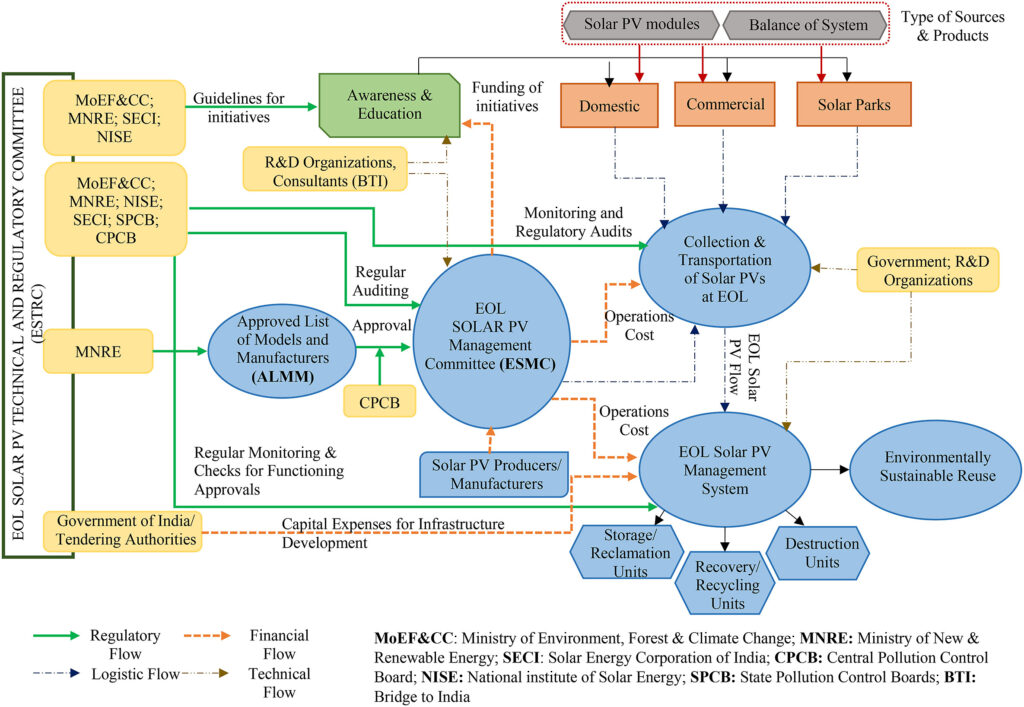
Solar waste — Policies and End-of-life solution
Recap — In part 01, ’Solar waste — A problem from the future’ was a top down inquiry into the scale of the problem of ‘solar waste’. Followed by Part 02, ‘How do Solar PV Cells work again?’ that mapped the materials and workings of a single solar PV panel. A zoomed inquiry of sorts.
Here in part 03, we will look at the suggested policy frameworks and possible end-of-life solutions for solar PV waste in India.
PV waste in India follows an unregularised, unscientific and informal approach at the moment. Regarded as ‘general electronic waste’ there is no mention of it as a potential waste stream in the E-waste (Management and Handling) Rules, 2011 and Municipal Solid Waste Management Rules (SWM), 2016.
Suggested policy frameworks for PV waste
‘PV Waste Management in India’, a report on renewable energy and energy efficiency makes recommendations based on the experience of the extended producer responsibility (EPR) policy approaches in several European countries.
It advocates creating an EPR legislation for PV modules separate from the E-Waste Rules to set the producers’ responsibility and provides a multi-sector and multi-stakeholder approach for solar PV waste management through the set up of two committees.
A technical and regulatory committee comprising representatives from relevant central ministries and departments, responsible for developing policies in consultation with different partner states to regulate the management of solar PV waste. This committee will also be accountable for ensuring the implementation and functioning of the framework to reduce EOL waste.
And a Management Committee, of PV manufacturers themselves or as a public-private partnership that will work under the technical and regulatory committee on the execution of EPR — Responsible for managing PVs that reach their EOL stage, including collection, storage, transport, recovery, and reclamation from the source (Repurchasing modules and developing the transportation systems between end-users and EOL management units for the solar PVs).
Further, a framework published by the Indian Institute of Technology, Tirupati and the National Institute of Disaster Management, proposes a regulatory framework aimed at mainstreaming the end-of-life (EOL) management of this waste. To summarise the key features and benefits of the regulatory framework are —
- Incorporates the EPR principle to increase the accountability and responsibility of manufacturers and to initiate the process of waste management at its source.
- Proposes the development of an efficient and sustainable national-level solar PV take-back system for recovery, reclamation and destruction from all sectors, along with a management and implementation strategy.
- Provide for the adoption of a multi-sector and multi-stakeholder approach for solar PV waste management.
- Cover capacity development and technician certification of workers involved in EOL management of solar PV waste by the government.
- Include awareness and educational programmes on the importance of responsible EOL management of solar PV waste for Indian citizens.
- Provides for strengthening of EOL of solar PV as an essential R&D thrust area for bringing technological innovations post EOL usage of solar PVs.
- Ensures minimisation of solar PV waste reaching the landfills by sustainable and environmentally friendly recovery of materials.

Solar waste as Architecture — A novel approach
A team of researchers at the Centre for Sustainable Technologies (CST), led by Dr Monto Mani and operating out of the Indian Institute of Science (IISc) are exploring new methods of upscaling old PV panels by using them as building material. This research will potentially allow designers, builders and architects to incorporate these panels as building material rather than as waste.
If these old panels might still be in working condition but at reduced output, it could potentially be used to power Wi-Fi points, and charging ports, thus providing alternative sources in architectural design itself.
State of Recycling
On the recycling front, SOFIES India and Poseidon Solar, have been using specially built environments with state-of-art physical and chemical cleaning methods to recover different types of silicon and cell raw material, bringing disposed and dead material back to the value chain. These initiatives are commendable but a few plants here and there will not be able to handle the future scale of the problem.
All in all, it seems that there are a multitude of challenges in the infrastructure including recycling technology, environmental protection, waste management, recycling policies and the economic aspects of recycling itself.
Even though there are positive developments at various ends of the spectrum, the need to establish an ecosystem for researchers, manufacturers, the government and citizens to avoid catastrophic disaster is the need of the hour. It is important for all stakeholders to recognize that sustainability comes at a cost, and the potential of it back firing as we hurl ourselves into the future is higher than we are ready to accept.


Leave a Reply